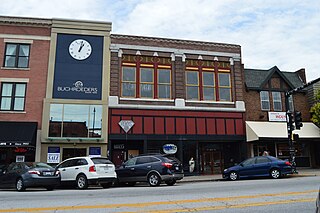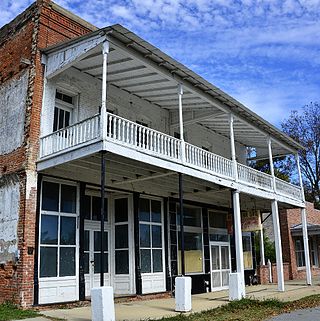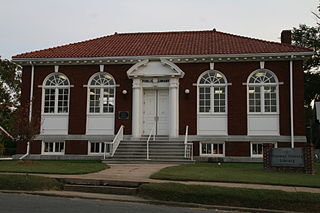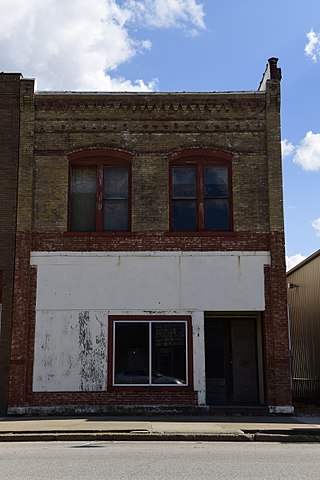
The Ballenger Building, also known as G.F. Troxell Furniture Store, Taylor Music and Furniture Co., and Safeway, is a historic commercial building located in downtown Columbia, Missouri. It was originally built about 1892, and expanded rearward about 1904. It was extensively remodeled in 1928. It is a two-story brick building on a stone foundation. It features terra cotta ornamentation and Chicago school style windows. Today it holds Kaldi's Coffee House.

The Community Theatre is a historic theatre building at 207 West 2nd Avenue in Pine Bluff, Arkansas. It is a two-story brick building, finished in stucco, with Moderne styling. It was built in 1889, and housed first a furniture store, and then a five and dime, before being converted for theatrical use in the 1920s. Its present Moderne styling dates to renovations made in the wake of a 1951 fire.

The Kress Building, also known as Kress Wholesale Company Store and Mehornay Furniture Store, is a historic commercial building located in downtown Columbia, Missouri. It was built in 1910 for the S. H. Kress & Co., and remodeled in 1946 when it became Mehornay Furniture. It is a tall two-story, brick building with an open storefront topped by horizontal metal banding, that consists of large plate glass windows.

The McCain Furniture Store Building is a historic commercial building located in downtown Columbia, Missouri. It was built about 1930 for the S. H. Kress & Co., and remodeled in 1951. It is a two-story, brick building with a simple stepped parapet. Though it has hosted a variety of businesses since the closing of the original store, today it holds Plasma Biological Services.

The Main Street Historic District in Lake Geneva, Wisconsin is a 2.5-acre (1.0 ha) historic district that was listed on the National Register of Historic Places on January 11, 2002. The listing was amended in some way in a revised listing on March 5, 2002. In 2002, there were 20 buildings in the district that were deemed to contribute to its historic character.

Central Office Building is a historic building located in downtown Davenport, Iowa, United States. It has been individually listed on the National Register of Historic Places since 1983. In 2020 it was included as a contributing property in the Davenport Downtown Commercial Historic District. It is located in the center of a block with other historic structures. It now houses loft apartments.

The Public Market, also referred to as the Morrill Block, is a historic commercial building at 93-95 Washington Street in Dover, New Hampshire. Built about 1846, it is one of the few surviving Greek Revival commercial buildings in the city, best known for its long association with the local Morrill Furniture Company. It was listed on the National Register of Historic Places in 1985.

The Arkansas City Commercial District encompasses the three oldest surviving commercial buildings in Arkansas City, Arkansas. They are located along Sprague (4th) Avenue, between Kate Adams (1st) Street and De Soto Avenue, and are a reminder of a once-thriving commercial district in the city. The Cotham Drug Store, a two-story brick building from c. 1900, stands near the corner of Sprague and De Soto, facing south. The Red Star Grocery, built 1900, stands to its right; it is also a two-story brick building, but its facade has been altered, replacing a recessed doorway with a flush one. Stylistically the two buildings are similar, with brick corbelling and a course of dentil molding, with a parapet above. The third building is the Ramus Brothers Market, which stands on Sprague Street, and was built in 1910 out of poured concrete.

The John Tushek Building is a historic commercial building at 108 Main Street in Lake Village, Arkansas. The two story brick building was built in 1906 by John Tushek, an Austro-Hungarian immigrant who ran a mercantile store on the premises. The building has vernacular Beaux Arts styling popular at the time, presenting facades to both Main and Court Streets. The ground floors of these facades are divided into storefronts with large glass windows, with access to the upper floor offices via an entrance on the corner. The second floor windows are capped with decorative metal crowns, and topped by small oculus windows. The facade is topped by a corbelled brick cornice and parapet.

The Anderson–Hobson Mercantile Store is a historic commercial building at 201 Schuman Street in Foreman, Arkansas. It is a three-story brick structure with modest Italianate styling, mainly visible in brick corbelling details and segmented-arch window crowns. It was built c. 1910, as part of a major growth spurt in the county following the arrival of the railroad. It is one of the few commercial buildings in the county to survive from that period.

The Hayes Hardware Store is a historic commercial building at 314 DeQueen Street in downtown De Queen, Arkansas. It is a brick 1+1⁄2-story structure, sharing party walls with adjoining buildings on either side. Its brick facade is divided into two three-bay sections, with brick pilasters at the ends and in the center. Above the first-floor storefront windows is a clerestory level, above which is an attic space, where each of the six bays has a small oculus window. Above the second and fifth bays is a rounded arch. The building was built c. 1900 by the Dierks Lumber and Coal Company, which built the De Queen and Eastern Railroad, making the city the commercial center of Sevier County. The building was acquired in 1908 by the Hayes Hardware Company.

The Kress Building is a historic commercial building at 210 West Main Street in Blytheville, Arkansas. It is a two-story concrete and steel structure, faced in brick and terra cotta. Built in 1938, it was one of the first buildings in the city to be built using steel framing, and is one of its finest Art Deco structures. The first floor areas are faced in terra cotta, while the second floor is predominantly cream-colored brick. Windows on the second floor are surrounded by ivory terra cotta incised with fluting and shell patterns.

The Pinkston–Mays Store Building is a historic commercial building at 107-109 Lackston Street in Lowell, Arkansas. It is a two-story brick building with a flat roof, and is divided into two storefronts, separated by a stairway leading to the second floor. The two storefronts are arranged identically, with a central entrance flanked by fixed glass windows. The elements of the first floor facade are separated by brick pilaster, and the storefronts are highlighted by brick corbelling above. Built in 1902, the building is a little-altered local example of early 20th century commercial architecture.
The Goldman and Son Store is a historic commercial building at 101 Main Street in Clarendon, Arkansas. Built in 1893, this single-story brick building with pressed-metal facade is the oldest commercial building in the city, and the only 19th-century commercial building in active use. It was first used by a dry goods and cotton merchant, and in 1930 converted for use by a fish dealer.

Powell Clothing Store is a historic commercial building at 201 North Main Street in Beebe, Arkansas. It is a two-story brick building, built about 1885 in what was then the city's economic heart. It is a basically vernacular structure, with modest brick corbelling on the cornice and panels of the front facade. It is one of only a few commercial buildings to survive in the city from that period.

The Pfeifer Brothers Department Store is a historic commercial building at 522-24 South Main Street in downtown Little Rock, Arkansas. It is a large three story brick structure, with load bearing brick walls and internal steel framing. The ground floor is lined with commercial plate glass display windows, separated by brick pilasters capped with capitals made of terra cotta.

The Conway County Library is the public library system of Conway County, Arkansas. The main library is located at 101 West Church Street in downtown Morrilton, Arkansas, the county seat. The library is located in a Classical Revival brick building designed by Thomas Harding and funded in part by a grant from Andrew Carnegie. In 1916 the Pathfinder Club of Morrilton applied for the grant. A lot was purchased, and Morrilton Mayor J. A. Frisby, Night Rainwater, and W. M. Riddick worked with a committee to construct the new library. The construction cost was $7,500, leaving $2,500 to purchase coal and furniture for the building. The building was completed in October 1916 and still serves as the Conway County Library. The building was listed on the National Register of Historic Places in 1978. The library organization began as a private collection in 1894, and was housed in private residences and vacant commercial buildings prior to the construction of this building.

The Giroux Furniture Company Building is a historic commercial building at 10-18 Catherine Street in the city of St. Albans, Vermont. Built in two parts, it is a reminder of the city's railroad-related history, and served for many years as an enduring commercial presence. It was listed on the National Register of Historic Places in 2006.
Perry’s Funeral Chapel, known for many years as Rumph Mortuary, is a historic commercial building at 312 West Oak Street in El Dorado, Arkansas. Built in 1927, it is a two-story red brick building, with a three-bay facade topped by a crenellated Gothic parapet. Charles Rumph, known as “C.B.”, came to El Dorado in the early 1920’s after the passing of his mother Martha Proctor Rumph, one of the original owners of Proctor Funeral Home in Camden, Arkansas. C.B. Rumph originally partnered with W.F. McWilliams, a local banker and furniture store owner. Their first location was on the corner of Elm and Cleveland and went by Rumph & McWilliams Undertaking. Rumph was the mortician and McWilliams supplied the caskets through his furniture store and the ambulances through his Studebaker dealership. However, in 1927 Rumph opened on his own and died young, forcing his two sons Tom and Dudley to become morticians and take over the operation. Through those years the funeral home was known as Rumph Mortuary, Rumph Undertaking & Ambulance Service, Rumph Funeral Directors, and Rumph Funeral Home. The firm had several owners after Tom and Dudley Rumph handed it down and several name changes all including the original Rumph name. Then in 2003 the name changed to Perry’s Funeral Chapel. This is the oldest funeral home in Arkansas and it has remained mostly untouched and unchanged as a monument to the oldest and noblest profession: undertaking.

The Ramsey Building is a historic building located in Keota, Iowa, United States. Eben J. Ramsey had the two-story, brick, Romanesque Revival commercial building constructed in 1895. Its significance is derived from its association with both the furniture and funeral business. Ramsey had both businesses in the building until 1907. He had to partially rebuild it after a fire in 1897. A furniture store continued to occupy the building until 1957. A funeral home was located here until 1937 when it was relocated to a house. This marked the separation of a business marketing goods with one that provided services. At the same time, the furniture store merged with the new appliance store, which represented a sift to selling traditional furnishings with modern conveniences for the home. The building was listed on the National Register of Historic Places in 2017.




















